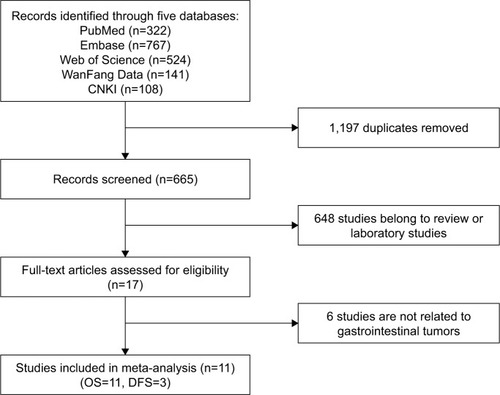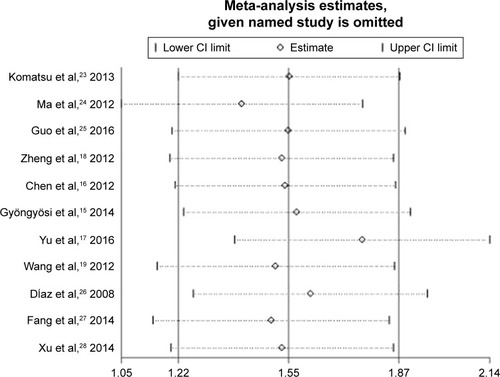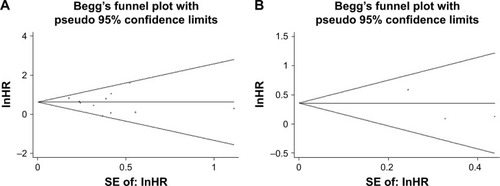Abstract
Background
There are accumulating studies investigating the aberrant expression of microRNAs in tumor patients. As an important member of miR-17/92 cluster, miR-17-5 p has been identified as a potential prognostic factor for survival in tumor patients. We conducted this meta-analysis aimed to assess the effect of miR-17-5 p as a prognostic biomarker for gastrointestinal tumor patients.
Materials and methods
Eligible studies were enrolled by searching the online databases of PubMed, Embase, Web of Science, China National Knowledge Infrastructure, and WanFang Data until September 2017. We calculated pooled hazard ratios (HRs) and 95% CI of miR-17-5 p for overall survival and disease-free survival.
Results
In the categorical variable analysis, we identified 11 studies with 1,279 patients. The pooled analyses suggested that overexpression of miR-17-5 p may predict poor overall survival (HR = 1.86, 95% CI: 1.55–2.25, P<0.001) and disease-free survival (HR = 1.43, 95% CI: 1.01–2.03, P=0.046) in patients with gastrointestinal tumors. Subgroup analysis showed the pooled HR of overall survival was more significant in tissue specimen, Asian patients, and digestive tract tumors. But there was no correlation between the outcomes and European patients.
Conclusions
This meta-analysis suggested that miR-17-5 p has predictive effects on overall survival and disease-free survival of patients with gastrointestinal tumors.
Introduction
MicroRNAs (miRNAs) are a class of single-stranded noncoding RNAs 21–22 nucleotides in length processed from much longer primary transcripts. They may regulate up to 60% of human protein-coding genes.Citation1 MiRNAs participate in crucial biological processes such as cell proliferation, differentiation, apoptosis, and tumorigenesis.Citation2–Citation4 MiR-17/92 cluster is one of the most popularly researched gene clusters and miR-17-5 p is an important member of the miR-17 family belonging to the miR-17/92 cluster. The human genome miR-17/92 cluster has two paralogues of the main cluster: the miR-106b/25 and the miR-106a/363 clusters. MiR-17/92 and miR-106b/25 are expressed abundantly in a wide spectrum of tissues but miR-106a/363 is expressed at lower levels. Together, these three miRNA clusters represent a combined total of 15 miRNAs that form four “seed” families: the miR-17 family, the miR-18 family, the miR-19 family, and the miR-92 family.Citation5 The miR-17/92 cluster encodes six miRNAs including miR-17, miR-18a, miR19a, mir19b, miR-20a, and miR-92a.Citation6 The recent studies showed that miRNAs are associated with prognosis in various cancers, suggesting that they could be used as prognostic classifiers to predict prognosis and guide therapeutic decisions.Citation7–Citation9 MiR-17-5 p was identified to have oncogenic or suppressive ability in several cancers. Many researchers have identified that the members of miR-17/92 cluster are closely connected with diagnosis and prognosis of many kinds of tumors.Citation10–Citation13 As the important member of miR-17/92 cluster, the influence of miR-17-5 p on the prognosis of glioblastoma, gastric carcinoma, hepatocellular carcinoma, lung cancer, pancreatic cancer, and malignant mesothelioma have been reported.Citation14–Citation22
However, there were still insignificant or opposite results. Therefore, we performed this meta-analysis to get a better understanding of the prognostic effect of miR-17-5 p on gastrointestinal cancer patients.
Materials and methods
Search strategy
The systematic literature search was carried out through the online databases of PubMed, Embase, Web of science, China National Knowledge Infrastructure (CNKI), and Wan Fang to retrieve eligible studies till September 2017. The keywords of “miR-17-5 p”, “miR17-5p”, “microRNA17-5p”, and “microRNA-17-5 p” were used to select the essays. Additionally, a manual search was conducted using all review articles on this topic. The researching of database was implemented by the authors QL and LB. The diagram of the study selection process is presented in .
Data extraction
The investigators (QL and LB) performed data extraction using a standard data extraction form to determine eligibility for inclusion and extract data. Discrepancies were adjudged by the third investigator (ML) until consensus was achieved. The following inclusion criteria were used to select eligible studies in our meta-analysis: 1) patients with gastrointestinal cancers are included; 2) publication details: the name of tumors, first author’s last name, and publication year; 3) characteristics of the studied population: follow-up time and stage of disease; 4) materials and methods of experiments; 5) miR-17-5 p assessment and cutoff definition; and 6) hazard ratios (HRs) of elevated miR-17-5 p for overall survival (OS) and disease-free survival (DFS) as well as their 95% CI and P-values. The HRs and their 95% CIs were performed in the original articles; if the HRs were not available, data were calculated following Tierney et al’s method.
Quality assessment
We used Newcastle–Ottawa scale to assess the quality of enrolled studies. There are three aspects in Newcastle–Ottawa scale: the selection of the study groups, the comparability of the groups, and measuring of outcomes. The score of this scale is ranged from 0 to 9.
Statistical analysis
To avoid calculating error, we pooled only HRs with their corresponding 95% CIs given explicitly in the publications in the analyses. Cochran’s Q test and Higgin’s I2 statistic were used to measure the heterogeneity between studies. If P>0.1 or I2<50%, fixed-effects model (Mantel–Haenszel test) was used; otherwise, random-effects model (DerSimonian and Laird method) was chosen. Sensitivity analysis was conducted by omitting one single research at a time and recounting HRs and 95% CIs to assess the stability of the meta-analysis results. Publication bias among the included studies was evaluated by Egger’s and Begg’s statistical tests. All P-values were two-sided. All statistical tests were analyzed by STATA 11.0 (STATA Corporation, College Station, TX, USA).
Results
Description of included studies
The flowchart of detailed searching process is illustrated in . We used the searching strategy described above to search the online databases of PubMed, Embase, Web of Science, CNKI, and Wan Fang. A total of 1,862 records were initially collected by our literature search strategy. After manually screening the titles and abstracts, our investigators excluded duplicates and articles that failed to meet the aim of our study. Then 17 records were assessed for full-text review. Finally, elevenCitation15–Citation19,Citation23–Citation28 studies that evaluated the prognostic effect of miR-17-5 p for OS and threeCitation16,Citation25,Citation26 studies for DFS were included.
Characteristics of eligible studies
A total of 1,279 cases from China, Japan, Spain, and Hungary were included to evaluate the relationship between miR-17-5 p expression and tumor prognosis. The patients were diagnosed with gastrointestinal cancers, including colorectal carcinoma, hepatocellular carcinoma, pancreatic carcinoma, gastric carcinoma, esophageal squamous cell carcinoma, and cholangiocarcinoma. Tissue and blood samples were used to determine expression levels of miR-17-5 p while quantitative real-time polymerase chain reaction had been used in all studies. The most frequently applied cutoff value was the median which was used in seven studies and others were different. Other basic characteristics are all listed in . All the HRs and their 95% CIs in the collected articles are shown in .
Table 1 Characteristics of studies included
Table 2 Summary of HRs and their 95% CI
Qualitative assessment
After using Newcastle–Ottawa scale to assess the quality of studies, the study quality varied from 5 to 9; the studies that achieved a score >6 were included. The clinicopathological characteristics of the eligible studies are summarized in .
Table 3 Quality assessment based on the Newcastle–Ottawa scale
Meta-analysis results
All the studies were pooled into this meta-analysis, and the result is shown in . As no heterogeneity was found in OS research (I2=22.6%, P=0.228) and DFS research (I2=0%, P=0.40), therefore, fixed model was applied. The result indicated that overexpression of miR-17-5 p significantly predicted poor OS (HR = 1.86, 95% CI: 1.55–2.25; ), and the effect reached the level of statistical significance (P<0.001). DFS was reported in three studies. The pooled HR of DFS was 1.43 (95% CI: 1.01–2.03, P=0.046; ), indicating that the high level of miR-17-5 p expression was related to poor DFS. Detailed analyses were also carried out. We further researched the meta-analysis of miR-17-5 p expression and OS in different cancer types: three studies including colorectal carcinoma, three studies including hepatocellular carcinoma, two studies including gastric carcinoma, one study including pancreatic carcinoma, one study including esophageal squamous cell carcinoma, and one study including cholangiocarcinoma (). No obvious heterogeneity was found in each subgroup. The results prompt that overexpression of miR-17-5 p was related to poor OS in colorectal carcinoma, hepatocellular carcinoma, and gastric carcinoma. But the difference was not significant in pancreatic carcinoma.
Figure 2 Forest plot of overall survival analysis and disease-free survival analysis.
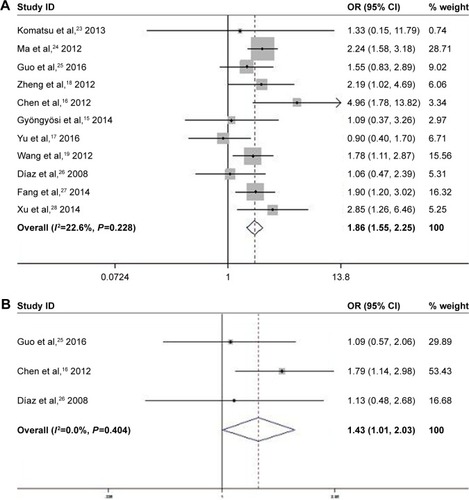
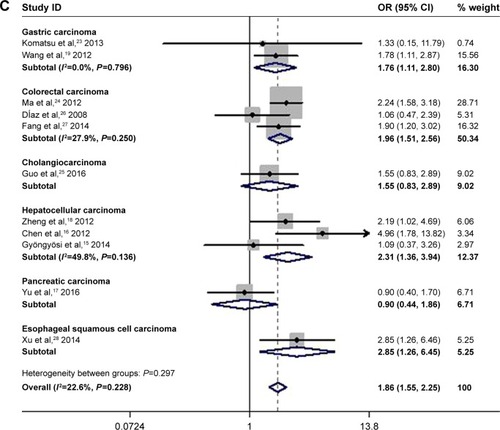
Subgroup analyses were conducted according to the main characteristics. The results showed that the predictive role of miR-17-5p was significant in blood specimen (HR = 1.70, 95% CI: 1.23–2.34, fixed-effects model), tissue specimen (HR = 1.90, 95% CI: 1.29–2.80, random-effects model), Asian patients (HR = 1.98, 95% CI: 1.61–2.38, fixed-effects model), digestive tract tumors (including gastric carcinoma, colorectal carcinoma, esophageal squamous cell carcinoma; HR = 1.97, 95% CI: 1.58–2.45, fixed-effects model), hepatobiliary system, and pancreas tumor (including hepatocellular carcinoma, pancreatic carcinoma, and cholangiocarcinoma; HR = 1.62, 95% CI: 1.14–2.31, fixed-effects model). The association between overexpressed miR-17-5 p and poor OS was not significant in the subgroup of European patients ().
Table 4 Meta-analysis of overall survival and subgroup analysis
Sensitivity analysis
Considering the number of the OS studies was more than ten, a sensitivity analysis was performed to assess the stability of the meta-analysis results. After omitting one study each time, the pooled HRs were calculated again. The stability of the entire study was not influenced by one individual study ().
Publication bias assessment
The Begg’s funnel plot and Egger’s test were applied to detect publication bias in this OS and DFS meta-analysis among included studies (). In OS and DFS meta-analysis, the values of Begg’s regression were 0.558 and 0.373. The result suggests that no obvious risk of publication bias was found in the meta-analysis.
Discussion
The function of miR-17-92 cluster had been reported in many different aspects. As an important member of miR-17-92 cluster, miR-17-5 p had been demonstrated playing an important role in aging of brain, heart, and bone. According to the recent researches, the review of Dellago summed up that miR-17-5 p is at the crossroads of aging, longevity, and cancer and can be used a biomarker or a therapeutic tool.Citation29
Emerging evidence indicate that the miR-17-92 cluster may play an important role in tumorigenesis as a novel class of oncogenes.Citation30,Citation31 MiR-17-5 p is one of the main effectors of the miR-17-92 cluster components. MiR-17-5 p, as a novel biomarker of prognosis in many types of cancer, has generated much interest. Many studies suggest that overexpression of miR-17-5 p plays important roles in increasing cell proliferation, migration, and invasion. MiR-17-5 p functions as a tumor suppressor in biological activities. Cheng et al revealed that miR-17-5 p promotes tumor cell migration by upregulating a calcium-activated potassium channel subunit alpha 1 (KCa1.1) in malignant pleural mesothelioma.Citation32 Li et al discovered that overexpression of miR-17-5 p in MCF-7 cells promote the invasive and migratory abilities by targeting HBP1 through β-catenin pathway.Citation33
In addition, the role of miR-17-5 p as an oncogene or tumor suppressor has also been reported in cervical cancerCitation34 and breast cancer.Citation35,Citation36 Furthermore, in gastrointestinal tumors, miR-17-5 p-induced phosphorylation of HSP27 enhances the migration of HCCs through the p38 MAPK pathway.Citation37 In gastric cancer, miR-17-5 p downregulated TGFBR2 expression, thereby promoting cell growth and migration.Citation38 GFRalpha2 influences cell growth and apoptosis through regulating tumor gene PTEN via mir-17-5 p in pancreatic cancer.Citation39
Up to now, many studies have reported that miR-17-5 p influences the effectiveness of the chemotherapy in some tumors in vivo. In Yan’s research, inhibiting miR-17-5 p expression increased chemosensitivity to gemcitabine in the Panc-1 and BxPC3 cells.Citation40 Fang et al found that miRNA-17-5 p promotes tumor metastasis and chemotherapeutic drug resistance of colorectal cancer by downregulating the expression of PTEN.Citation27 Chatterjee et al examined that miR-17-5 p downregulation contributes to paclitaxel resistance through altering Beclin1 expression in lung cancer.Citation41 By performing a similar study in radiotherapy, Wu et al identified that miRNA-17-5 p regulated radiosensitivity in oral squamous cell carcinoma.Citation42 The downregulated mir-17-5 p in esophageal adenocarcinoma cancer stem-like cells may promote the radioresistant phenotype.Citation43
Recently, many studies reported that miR-17-5 p is associated with poor OS in many types of tumor. However, the sample size of these studies is relatively small. In most researches,Citation14,Citation16,Citation18,Citation19 miR-17-5 p indicates a poor prognosis in hepatocellular, lung, and gastric carcinomas. But there is still argument between the function of overexpression of miR-17-5 p and predicting the survival. In Yu et al’s multivariate survival analyses of pancreatic cancer and Gyöngyösi et al’s research of hepatocellular carcinoma, there was no significant association between overexpression of miR-17-5 p level and the OS time.Citation15,Citation17 In contrast, in Srinivasan et al’s study of glioblastoma,Citation20 overexpression of miR-17-5 p was proved to contribute to increase the patients’ survival time. With the increasing number of researches related to miR-17-5 p in gastrointestinal tumors, we noted that half of researches about the prognostic value of miR-17-5 p in gastrointestinal tumors were insignificant. So we conducted this meta-analysis aiming to better understand the association between miR-17-5 p expression and survival in gastrointestinal tumor patients. Our study included eleven researches and higher expression of miR-17-5 p predicted poor OS (HR = 1.86, 95% CI: 1.55–2.25; fixed-effects model) and poor DFS (HR = 1.43, 95% CI: 1.01–2.03; fixed-effects model). Nevertheless, the present study has some limitations that require consideration. First, our study analyzed only unvaried factors; we did not stratify and analyze factors such as gender, treatment, and environmental variables due to lack of data. Second, the types of tumor are still deficient. Third, the analysis of the expression of miR-17-5 p and DFS is based only on three studies, one from each of three different cancer types including one study looking at plasma expression. Fourth, although our research shows that miR-17-5 p is significantly correlated with the prognosis of gastrointestinal tumors, the clinical characteristics of different tumors may affect the combined results. The influence of different sample sources (tissue/serum) on the combined results should also be taken into consideration. Therefore, a more precise analysis needs to be performed.
Conclusion
In conclusion, the results of our meta-analysis support a potential prognostic role for miR-17-5 p in some cancers. Further studies should be performed to analyze the association between prognosis and other clinic characteristics.
Disclosure
The authors report no conflicts of interest in this work.
References
- FangZYinSSunRmiR-140-5p suppresses the proliferation, migration and invasion of gastric cancer by regulating YES1Mol Cancer201716113928818100
- YangWWeiJGuoTShenYLiuFKnockdown of miR-210 decreases hypoxic glioma stem cells stemness and radioresistanceExp Cell Res20143261223524930954
- ShenYGongJMZhouLLShengJHMiR-451 as a new tumor marker for gastric cancerOncotarget2017834565425654528915610
- ShenJZhangJXiaoMYangJZhangNMiR-203 Suppresses Bladder Cancer Cell Growth and Targets the Twist1Oncol Res Epub201796
- MogilyanskyERigoutsosIThe miR-17/92 cluster: a comprehensive update on its genomics, genetics, functions and increasingly important and numerous roles in health and diseaseCell Death Differ201320121603161424212931
- FeuermannYRobinsonGWZhuBMThe miR-17/92 cluster is targeted by STAT5 but dispensable for mammary developmentGenesis201250966567122389215
- QinCHuangRYWangZXPotential role of miR-100 in cancer diagnosis, prognosis, and therapyTumour Biol20153631403140925740059
- WuMYFuJXiaoXWuJWuRCMiR-34a regulates therapy resistance by targeting HDAC1 and HDAC7 in breast cancerCancer Lett2014354231131925173798
- ChenAHQinYETangWFTaoJSongHMZuoMMiR-34a and miR-206 act as novel prognostic and therapy biomarkers in cervical cancerCancer Cell Int2017176328615991
- SuZXZhaoJRongZHWuYGGengWMQinCKDiagnostic and prognostic value of circulating miR-18a in the plasma of patients with gastric cancerTumour Biol20143512121191212525416437
- KomatsuSIchikawaDTakeshitaHCirculating miR-18a: a sensitive cancer screening biomarker in human cancerIn Vivo201428329329724815829
- MaQPengZWangLmiR-19a correlates with poor prognosis of clear cell renal cell carcinoma patients via promoting cell proliferation and suppressing PTEN/SMAD4 expressionInt J Oncol20164962589259927779660
- YangRFuYZengYSerum miR-20a is a promising biomarker for gastric cancerBiomed Rep20176442943428413641
- ChenQSiQXiaoSPrognostic significance of serum miR-17-5p in lung cancerMed Oncol201330135323263848
- GyöngyösiBVéghÉJárayBPretreatment MicroRNA Level and Outcome in Sorafenib-treated Hepatocellular CarcinomaJ Histochem Cytochem201462854755524804874
- ChenLJiangMYuanWTangHmiR-17-5p as a novel prognostic marker for hepatocellular carcinomaJ Invest Surg201225315616122583011
- YuJOhuchidaKMizumotoKFujitaHNakataKTanakaMMicroRNA miR-17-5p is overexpressed in pancreatic cancer, associated with a poor prognosis, and involved in cancer cell proliferation and invasionCancer Biol Ther201010874875720703102
- ZhengJDongPGaoSWangNYuFHigh expression of serum miR-17-5p associated with poor prognosis in patients with hepatocellular carcinomaHepatogastroenterology20136012354955223108086
- WangMGuHWangSCirculating miR-17-5p and miR-20a: molecular markers for gastric cancerMol Med Rep2012561514152022406928
- SrinivasanSPatricIRSomasundaramKA ten-microRNA expression signature predicts survival in glioblastomaPLoS One201163e1743821483847
- BusaccaSGermanoSde CeccoLMicroRNA signature of malignant mesothelioma with potential diagnostic and prognostic implicationsAm J Respir Cell Mol Biol201042331231919502386
- ZakrzewskaMFendlerWZakrzewskiKAltered MicroRNA Expression Is Associated with Tumor Grade, Molecular Background and Outcome in Childhood Infratentorial EpendymomaPLoS One2016117e158464
- KomatsuSIchikawaDTsujiuraMPrognostic impact of circulating miR-21 in the plasma of patients with gastric carcinomaAnticancer Res201333127127623267156
- MaYZhangPWangFElevated oncofoetal miR-17-5p expression regulates colorectal cancer progression by repressing its target gene P130Nat Commun20123129123250421
- GuoMTanMYeTExpression of serum microRNA-17-5p in patients with cholangiocarcinoma and its clinical significanceChinese Journal of Modern Medicine201626194246
- DíazRSilvaJGarcíaJMDeregulated expression of miR-106a predicts survival in human colon cancer patientsGenes Chromosomes Cancer200847979480218521848
- FangLLiHWangLMicroRNA-17-5p promotes chemotherapeutic drug resistance and tumour metastasis of colorectal cancer by repressing PTEN expressionOncotarget20145102974298724912422
- XuXLJiangYHFengJGSuDChenPCMaoWMMicroRNA-17, microRNA-18a, and microRNA-19a are prognostic indicators in esophageal squamous cell carcinomaAnn Thorac Surg20149731037104524360091
- DellagoHBobbiliMRGrillariJMicroRNA-17-5p: At the Crossroads of Cancer and Aging – A Mini-ReviewGerontology2017631202827577994
- LiuDDongLLiuYA c-Myc/miR-17-5p feedback loop regulates metastasis and invasion of hepatocellular carcinomaTumour Biol20163745039504726546431
- WangMGuHQianHmiR-17-5p/20a are important markers for gastric cancer and murine double minute 2 participates in their functional regulationEur J Cancer20134982010202123333058
- ChengYYWrightCMKirschnerMBKCa1.1, a calcium-activated potassium channel subunit alpha 1, is targeted by miR-17-5p and modulates cell migration in malignant pleural mesotheliomaMol Cancer20161514427245839
- LiHBianCLiaoLLiJZhaoRCmiR-17-5p promotes human breast cancer cell migration and invasion through suppression of HBP1Breast Cancer Res Treat2011126356557520505989
- WeiQLiYXLiuMLiXTangHMiR-17-5p targets TP53INP1 and regulates cell proliferation and apoptosis of cervical cancer cellsIUBMB Life201264869770422730212
- FanMSethuramanABrownMSunWPfefferLMSystematic analysis of metastasis-associated genes identifies miR-17-5p as a metastatic suppressor of basal-like breast cancerBreast Cancer Res Treat2014146348750225001613
- HossainAKuoMTSaundersGFMir-17-5p regulates breast cancer cell proliferation by inhibiting translation of AIB1 mRNAMol Cell Biol200626218191820116940181
- YangFYinYWangFmiR-17-5p Promotes migration of human hepatocellular carcinoma cells through the p38 mitogen-activated protein kinase-heat shock protein 27 pathwayHepatology20105151614162320209605
- QuYZhangHDuanJMiR-17-5p regulates cell proliferation and migration by targeting transforming growth factor-beta receptor 2 in gastric cancerOncotarget2016722332863329627120811
- GuJWangDZhangJGFRalpha2 prompts cell growth and chemoresistance through down-regulating tumor suppressor gene PTEN via Mir-17-5p in pancreatic cancerCancer Lett2016380243444127400681
- YanHJLiuWSSunWHmiR-17-5p inhibitor enhances chemo-sensitivity to gemcitabine via upregulating Bim expression in pancreatic cancer cellsDig Dis Sci201257123160316723001407
- ChatterjeeAChattopadhyayDChakrabartiGmiR-17-5p downregu-lation contributes to paclitaxel resistance of lung cancer cells through altering beclin1 expressionPLoS One201494e9571624755562
- WuSYWuATLiuSHSyWAtWMicroRNA-17-5p regulated apoptosis-related protein expression and radiosensitivity in oral squamous cell carcinoma caused by betel nut chewingOncotarget2016732514825149327285985
- Lynam-LennonNHeaveySSommervilleGMicroRNA-17 is downregulated in esophageal adenocarcinoma cancer stem-like cells and promotes a radioresistant phenotypeOncotarget201787114001141328002789

